Physics For Civil Engineering: Unit III: Acoustics and Lighting Designs
Principles of Artificial Lighting
Light can be produced by nature or by humans. "Artificial" light is typically produced by lighting systems that transform electrical energy into light.
PRINCIPLES OF ARTIFICIAL LIGHTING
Light can be produced by nature or by
humans. "Artificial" light is
typically produced by lighting systems that transform electrical energy into
light.
Nearly
all lighting systems use electrical current or through
1. Categories of light
There
are '3' categories of light. They are
(a)
Direct
(b)
Reflected
(c)
Indirect
(a) Direct
Direct
light is light travelling unimpeded from the light source to the subject. It is
not filtered, diffused, reflected or altered. Direct light is like the sun
light on a clear day.
The
effect of extensive use of lighting is direct, impressive and active both
ambient light and artificial light.
(b) Reflected
Second
type is semidirect (or) reflected lighting. It is visible but brightness is
less.
Reflected
light is light proceeding from a light source, reflected by a remote surface
and incident onto an object. Light reflected into an umbrella with a black
backing is an example of reflected light.
Light
can also be reflected off a white wall or a silver card and directed towards a
subject. Reflected light is less directional than an unimpeded source light.
(c) Indirect light
The third type is indirect lighting. It
is invisible but it falls on working area.
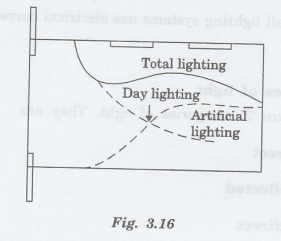
The
combination of 3 types of lighting can be used on any lighting systems. All the
methods give pain to the eyes, if proper lighting is not set in. Table lamp is
useful but it is harmful to the eyes.
Artificial light sources
The
most common five artificial light sources are as follows:
1.
Incandescent lamp
2.
Fluorescent tube
3.
Compact Fluorescent Lamp (CFL)
4.
Discharge lamp
5.
Light Emitting Diode (LED)
1. Incandescent lamp
Until
recently the most common electric light source is an incandescent lamp.
This
lamp consists of a filament made up of fine tungsten wire fixed inside the
glass support produces light as shown in fig. 3.17.
A
larger variety of shapes, sizes and power as well as different colour ranges is
available.
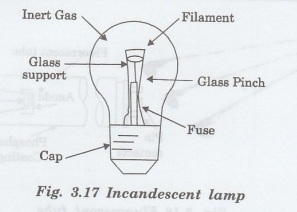
Typical
lamps for household use range from 40 to 100 W. The light output of 420 to 1360
lm is produced at the typical lamp efficiency of about 12%.
This
is still widely used, although it has relatively low energy efficiency. It
leads to replacement by other more efficient lamps such as the CFL.
2. Fluorescent lamp
Fluorescent
lamp is the main form of lighting for offices and commercial buildings. It uses
fluorescence to produce visible light.
It
is a gas discharge lamp. It is formed in a long thin glass cylinder. This lamp
has contacts at either end that secure them to the fitting (or luminaire) and
provide the electrical connection.
The
tube contains mercury vapour at low pressure. The inner wall of the glass is
coated with a phosphor that reacts to ultra-violet radiation.
When
electricity is passed through the vapour, it emits UV radiation that is
converted by the phosphor to visible light. (Fig. 3.18).
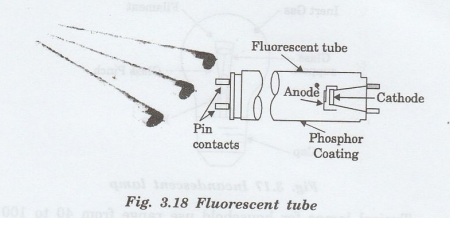
3. Compact Fluorescent Lamp (CFL)
The
Compact Fluorescent Lamp (CFL), is a fluorescent lamp and it is designed as a
more efficient replacement for incandescent lamp. It can be used in many light
fittings designed for incandescent lamps (Fig. 3.19a & b). It works on the
same principle as that of fluorescent lamp.
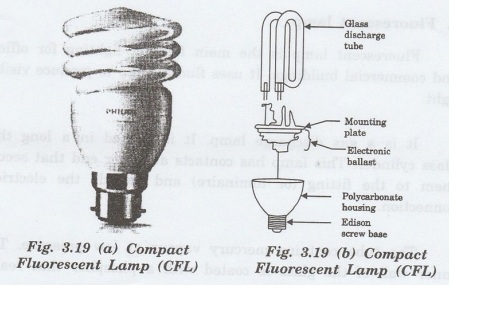
4. Discharge Lamp
In
discharge lamp, the light is produced by the passage of an electric current
through a gas or vapour as shown in fig. 3.20.
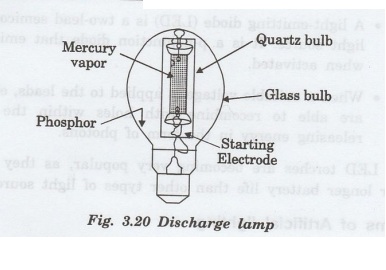
The
different metals and filler gasses can be used to provide a range of colour and
brightness. (Fig. 3.20)
The discharge lamps provide high
luminous efficacy combined with long life.
5. Light Emitting Diode (LED)
LEDs
use semiconductors to convert electrical energy directly into light. They are
only recently becoming available as a light source for lighting purposes. They
are highly efficient and long lasting. (Fig. 3.21)
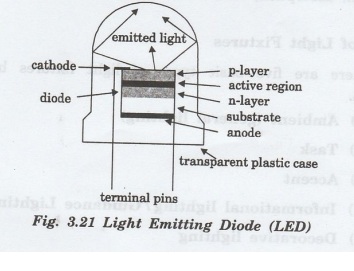
•
A light-emitting diode (LED) is a two-lead semiconductor light source. It is a
p-n junction diode that emits light when activated.
•
When a suitable voltage is applied to the leads, electrons are able to
recombine with holes within the device, releasing energy in the form of
photons.
LED
torches are becoming very popular, as they provide a far longer battery life
than other types of light source.
Forms of Artificial lighting
There
are two forms of artificial lighting. They are beau od 89 29
1.
Indoor lighting
2.
Outdoor lighting
1. Indoor Lighting
Indoor lighting is usually accomplished
using light fixtures, and it is a key part of interior design.
Luminaire
is a device that distributes filters or transforms the light emitted from one
or more lamps. The luminaire includes all the parts necessary fo for fixing and
protecting the lamps.
The
basic physical principles used in optical luminaire are reflection, absorption,
transmission and refraction.
Types
of Light Fixtures
There
are five basic types of light fixtures based on function.
(a)
Ambient (general lighting)
(b) Task
(c)
Accent
(d)
Informational lighting/Guidance Lighting
(e)
Decorative lighting
(a) Ambient
Ambient
lighting provides an area with overall illumination. Also it is known as
general lighting and it radiates a comfortable level of brightness without
glare.
Ambient
lighting is often provided by traditional pendant type fixtures, down lights,
chandeliers, or ceiling mounted fixtures, etc.
The
general decor and respect of the room will affect the amount of general
lighting required. Having a central source of ambient light in all rooms is
fundamental to a good lighting
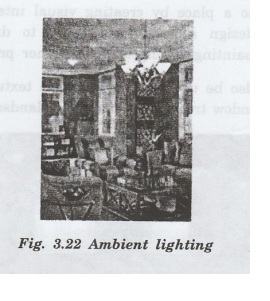
(b) Task Lighting
Task
lighting, or directional lighting, is aimed at a specific task. It provides
sufficient light on to perform a task that requires more re light than the
ambient fixtures.
It
can be provided by recessed and track lighting, pendant lighting under cabinet
lighting and desk lamps (Fig 3.23)
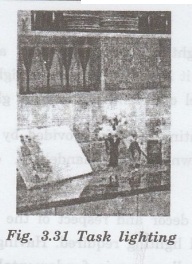
(c) Accent Lighting
eme nut ai or Ils ai digil Jasidms
Accent
lighting is also a sort of a directional lighting that adds drama to a place by
creating visual interest. As part of an interior design scheme, it is used to
draw the eye to houseplants, paintings, sculptures and other prized
possessions.
It
can also be used to highlight the texture of a brick or stone wall, window
treatments or outdoor landscaping (Fig 3.24).
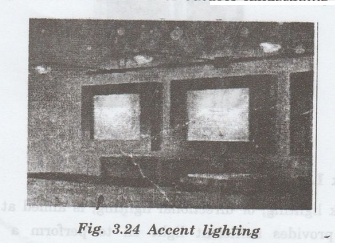
(d) Informational Lighting (Guidance Lighting)
It is designed to see our way safely. The light in our closet, the light by our door bell and night lights, as well as path lighting and motion lights, are all good examples of informational lighting.
Figure 3.25 is a typical night light with a photosensor. Informational lighting can be beautiful as well as functional, and can create dramatic statements. Lights inset on stairs can create pathways that enhance architecture, while outdoor informational lighting can create shadows and texture.
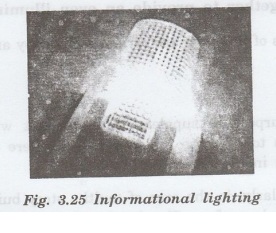
(e) Decorative Lighting
Light
strips, pendants, chandeliers, and sconces are all examples of light fixtures
that draw attention to themselves and add character to the place being lighted.
Many are used for general lighting (Fig. 3.26).
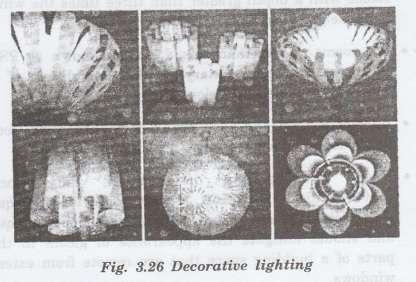
Physics For Civil Engineering: Unit III: Acoustics and Lighting Designs : Tag: : - Principles of Artificial Lighting
Related Topics
Related Subjects
Physics for Civil Engineering
PH3201 2021 Regulation | 2nd Semester Civil Dept 2021 Regulation
